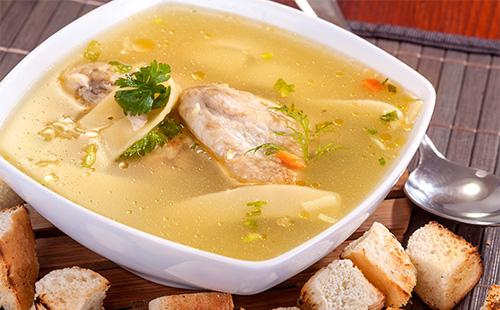The content of the article
Constipation is a condition where the physiological rhythm of cleansing the body is disrupted. It is accompanied by a decrease in the tone of smooth muscles of the lower intestines, a complete or partial lack of motility. In addition to drugs, it is possible to influence the work of internal organs with the help of food. In this case, the problem is eliminated in a natural way, without the risk of getting used to chemicals. An additional advantage of diet correction is the transition to a healthier way of eating.
Who needs a therapeutic diet number 3
Diet No. 3 is aimed at a complete restructuring of the patient’s diet. His diet needs to be saturated with a sufficient amount of insoluble dietary fiber, liquid, natural stimulants of peristalsis and excretion of digestive juices. Diet number three is constipation of varying duration, regularity and difficulty level. They can accompany functional disorders in the functioning of the intestinal mucosa or can be caused by an improper diet and diet.
The transition to this type of treatment table is recommended:
- if there is a chronic bowel disease with reduced motility;
- during the recovery period after exacerbation of chronic pathologies;
- with a tendency to constipation as a result of malnutrition;
- with constipation without concomitant diseases in children and the elderly.
The ideal time to switch to the diet of the third table is the period of attenuation of exacerbation of intestinal pathology. In the acute process, drug therapy is used, followed by the observance of the rules of the medical diet (approximately on the third day after the start of treatment).
A diet for every day belongs to a complete and absolutely safe, but its independent appointment is possible only if the patient is firmly convinced that a lack of water in the diet or improper food is the provocateur of stool disorders.
Why restrictions are useful
The purpose of the appointment of treatment table No. 3 is to softly stimulate peristalsis and secretory activity of all sections of the intestine (without excessive irritation of the mucosa of the upper and lower gastrointestinal tract). This pattern of food intake should normalize the metabolic mechanisms in the body, eliminate physiological discomfort and the pathological process. Diet can be used for a long time, accompany the transition to a healthy diet. During it, the patient will be able to:
- accelerate and stabilize metabolism;
- clear the intestines of toxins;
- normalize stool;
- get rid of bloating;
- get rid of a few kilograms;
- cleanse the skin.
One of the purposes of the appointment is bowel cleansing.The result is the elimination of putrefactive and fermentation processes, the reduction of the toxic load on systems and organs.
General principles of nutrition
Diet number 3 (table number 3) is designed to adjust the intestines without creating a nutrient deficiency for the body. It maintains a balance of proteins, fats and carbohydrates (BJU), taking into account the specifics of the problem.
It eliminates the use of products that provoke the processes of decay and fermentation in the intestine. As well as those that create a load on other digestive organs (fatty, mucous, too starchy dishes). An additional ban is on products containing too many essential oils, as they can provoke inflammation of the mucous membranes.
The preferred heat treatment is steaming. Allowed cooking on water, as well as stewing. The main part of the diet is raw and processed fruits and vegetables (sources of soft dietary fiber). Fried and baked foods will have to be completely abandoned: the formation of crisps is an extra risk of damaging the gastrointestinal mucosa and creating a strain on the pancreas.
The nature of the grinding of products is important - they are prepared in pieces or rubbed on a coarse grater. Puree and mucous dishes for nutrition in the third table are not suitable.
The chemical composition of diet No. 3:
- animal protein - 55 g;
- vegetable protein - 45 g;
- animal fat - 70 g;
- vegetable fat - 30 g;
- carbohydrates - 400 g;
- salt - about 8 g.
The total mass of food should be 2.7-3 kg. The recommended caloric content of the daily diet is 2700-2900 kcal. The energy value of products can vary depending on the age, health status and needs of the patient. When cooking, there is no need to limit the amount of salt, however, it is not worth overloading food. During the day, the patient needs to drink about 1.5 liters of pure water.
The nutritional scheme, subject to the third table, involves four to six meals a day. It is important to maintain equal intervals between them, as well as to prevent large breaks (the latter contribute to a slowdown of intestinal motility). Another feature of this diet is the regularity of meals. It is advisable to conduct both main meals and snacks at the same time. Then the work of the intestines will be regular.
What to make a diet from
The main place in the diet is occupied by fruits and vegetables, juices, prepared from them, as well as dairy products. Serving size should be small and approximately equal throughout the day. The table of products will orient what you can eat on diet No. 3.
Table - Recommended Diet No. 3 Products
| Product Category | Dishes | Cooking features | Frequency of use |
|---|---|---|---|
| First meal | - Vegetable soups; - borscht; - beetroots | - Based on fat-free meat or fish broths; - vegetable broth is considered ideal | Daily at lunchtime |
| Bread | Bread and pastries consumed stale or oven-dried | - Grain; - wheat; - rye varieties of the second grade; - inedible pastries with fillings | - Bread - daily; - baking - up to 2 times per week |
| Meat | Chicken and turkey, cleaned of fascia and skin | - The meat is steamed in chopped form or in pieces; - for first courses can be boiled in water | Daily as a source of protein |
| A fish | - Only low-fat river and sea varieties; - all kinds of seafood are allowed | Dishes are steamed or boiled in slices | Optimum 2-3 times a week (if desired, permissible more often) |
| Dairy products, eggs | - All types of dairy products; - fresh cottage cheese in its raw form, as well as in cheesecakes, lazy dumplings, casseroles; - milk, sour cream and cream in dishes; - scrambled eggs; - omelets | - Milk and cream are added to drinks; - sour cream is used for making sauces; - omelets are cooked in the oven or steamed | - Dairy products - daily; - whole milk - 3 times a week; - no more than two eggs per day |
| Cereals | - Buckwheat; - barley; - millet; - wheat | Porridge is boiled in water (milk and butter can be added) | Daily (dietary basis) |
| Vegetables | - Tomatoes; - beets; - carrot; - zucchini; - cucumbers; - pumpkin; - cauliflower and broccoli; - if well tolerated - white cabbage and green peas | - Salads are prepared from raw vegetables; - vegetables are boiled, steamed and in the oven in the form of casseroles | Daily (dietary basis) |
| Sweets | - Juicy and sweet ripe soft fruits; - dried fruits; - marmalade, pastille, jam; - honey | - Fruits are thoroughly washed; - there is no need to convert products to mashed potatoes | Daily |
The patient can afford the use of vinaigrette, soaked herring, aspic from the tongue, liver, meat and fish, as well as low-fat varieties of ham and mild hard cheeses. As sauces, you can use tomato, as well as bechamel. Instead of hot spices, a copious amount of finely chopped greens should be used.

What foods should not be consumed
Contraindications for people following the medical diet No. 3 are hard-to-digest foods that are devoid of dietary fiber or that contain too coarse their types. Fatty, spicy, sour, too salty and smoked foods are not allowed. List of foods excluded from the diet:
- among bread products - under the complete ban is first-class fresh bread, as well as pastries from pastry, puff;
- among meat products - the use of fibrous poultry meat (goose and ducklings), as well as fatty smoked meats and canned foods, is prohibited;
- among fish dishes - you should abandon smoked fish, fatty varieties of freshwater and marine species;
- from cereals - it is undesirable to eat vermicelli, sago, rice andsemolina porridge;
- from vegetables - It is forbidden to use odorous species (radish, onions, radishes, garlic), as well as all types of mushrooms;
- their desserts - You can not pectin fruits (quince, cornel, currants, blueberries), creams, jelly, chocolate.
Right menu
Assessing the approximate diet menu number 3, we can safely call it diverse. Plus and in the simplicity of food processing: the third table does not require a huge investment of time and the development of some special recipes.
Example No. 1
Simple dishes can become more delicious if you add greens to them. Instead of snacks, you can use several steamed fruits of prunes. Recommended meals:
- breakfast - green vinaigrette, soft-boiled egg, green tea;
- dinner - soup made with vegetables, loose buckwheat, meat goulash;
- dinner - fish baked in foil, mashed potatoes and carrot and cabbage salad in sour cream with herbs.
Example No. 2
The process of restoring the intestinal mucous membranes requires the intake of a sufficient amount of protein in the body, so do not neglect dishes from high-quality dietary meat. Menu for the day:
- breakfast - raw vegetable salad with poultry, steam omelette, coffee drink fromchicory;
- dinner - low-fat fish soup with vegetables, beets stewed with sour cream, boiled meat;
- dinner - vegetable stew with steam patties.

Example No. 3
Cottage cheese, allowed with the "troika", gives room for the flight of culinary imagination. You can cook cheesecakes, lazy dumplings, puddings with honey and fruits. Example of a “curd” menu:
- breakfast - a salad of baked beets and carrots seasoned with grape oil, as well as cottage cheese pudding;
- dinner - beetroot soup, meat stew with mixed vegetables;
- dinner - cheesecakes or lazy dumplings seasoned with low-fat sour cream and a handful of berries.
The treatment table number 3 does not imply the use of solid mashed potatoes and fresh dishes. The patient’s disposition contains a whole set of pleasant first, satisfying main dishes, as well as an abundance of fruit for fragrant desserts. The main rule to be learned is the absence of fat and fried crusts. With strict adherence to the diet, the intestines gratefully work in a normal rhythm.
Reviews
You should always eat properly, and not when constipation has already begun. Fiber - very good, support! And make sure that there is no senna in the remedies for constipation. Sooo doubtful pleasure from such a painful way.
Torika http://www.woman.ru/health/diets/article/100775/
As a result of general treatment (including this diet helped), the son began to gain weight, before that his weight seemed to be in one place in the region of 15 kg, although, given his age, he should weigh more and grow (currently gained a couple of kg and a few cm). Appetite also appeared, although before eating almost nothing.
Natalia31, http://irecommend.ru/content/v-nashe-vremya-neprosto-ee-priderzhivatsya-i-podbirat-produkty-stol-3-i-5

